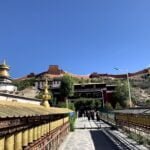Tuolin Temple: A Monument of Tibetan Heritage
Tuolin Temple, known as the “Flying Temple” in Tibetan, holds paramount significance in the annals of Tibetan history. The construction of this magnificent Indian-style Buddhist temple spanned decades and required the collective efforts of the finest architects, artists, and numerous monks of its era. Whether one attributes it to igniting the Tibetan Buddhist revival movement around 1000 AD or considers it the pivotal birthplace of the Shangshung Dynasty, which predates the Tubo regime, the Tholing Temple has left an indelible mark on the Buddhist culture of the Tibetan Plateau, shaping its trajectory for millennia.
Amidst the arid expanse of yellow sand, Tholing Temple’s distinctive temples and pagodas emit a radiance that is uniquely their own, illuminating the spiritual and cultural landscape of Tibet.

Historical and Cultural Significance of Tholing Monastery
In 996, King Yeshi-O, descendants of the Tubo dynasty established the first monastery in the Ngari region, Tuolin Temple. Yeshi-O, a devout Buddhist, sent 21 youths to Kashmir to study Tantric Buddhism. Of these, only Rinchen Zangpo and one other survived and returned. Rinchen Zangpo, later revered as a great Buddhist translator and adept, played a key role in translating Buddhist sutras and fostering Buddhism at Tholing.
This temple was initially built to aid the translation of Buddhist texts for Rinchen Zangbu, a renowned monk and translator in the later period of Tibetan Buddhism. By 1036, King Guge expanded the Tuolin Temple, enhancing its role in scripture translation and the promotion of Buddhism. Eventually, it became a key centre for propagating Buddhist culture during the Guge Dynasty.
Fall of Guge Kingdom and Damage to Temple
However, the 1630s brought turmoil when the Guge dynasty fell to the Kingdom of Ladakh. This occupation, lasting over half a century, led to the looting of many Buddhist statues and scriptures from the Tuolin Temple. The temple’s murals also suffered considerable damage during this time. In the mid-18th century, the seventh Dalai Lama, Kelsang Gyatso, transformed Tuolin Monastery into a branch of the Sera Monastery’s Jieba Zhacang. From then on, a three-year rotation system for the roles of Khenpo and Tripa was established, with appointments made by the Sera Monastery in Lhasa. This practice continued until the period of democratic reform.
Despite over 900 years of history, marked by natural destruction and human conflicts, Tuolin Monastery has endured, living up to its Tibetan name which means ‘soaring’. It remains a significant historical and cultural site, leaving an indelible mark for future generations to appreciate and learn from.
Architectural Splendor of Tholing Monastery
Tuolin Temple’s enduring influence on Tibetan Buddhism and its unique architectural beauty continue to make it a symbol of the rich cultural heritage of the Tibetan Plateau.
Architectural and Artistic Brilliance
The monastery is renowned for its exceptional murals, which represent a unique artistic heritage, making it a valuable resource for studying ancient Tibetan architecture, sculpture, painting, and art. These murals showcase a fusion of religious themes and local styles, providing insights into the religious and cultural milieu of the time.
The Tuolin Temple in Ngari, Tibet, may appear unassuming from the outside, resembling a modest small temple. However, those with a deeper understanding are aware that beneath its unpretentious exterior lies a remarkable treasure—the murals.
Unique Design: Symbol of Persistence
Located in the northwest corner of the Kassa Hall of Tuolin Monastery, there is a pagoda with a history that has weathered the passage of time. Sadly, more than half of the structures, statues, and murals on the exterior of the pagoda and the hall within it have suffered damage over the years. The temple features niches on its east, north, and south sides. The east niche houses a clay statue of a standing Buddha, while the north and south niches are adorned with standing clay statues of Bodhisattvas. Remarkably, the Kashmir-style murals, though aged, still retain their vibrant colours. These murals depict various subjects, including representations of Tara, Vajra, Dharma protectors, monks paying homage to Buddha, and generous donors.
Lakang Karbo
The White Hall, also known as “Lakang karbo” in Tibetan, derives its name from the combination of “Lakang,” meaning palace, and “karbo,” signifying white, due to its distinctive white outer walls. This significant structure is situated on a one-story platform on the western side of the Tara Hall within the Tuolin Temple ruins, covering a total area of 377 square meters. Notably, it holds the distinction of being the largest building within the Guge Kingdom.
The Assembly Hall stands as one of the oldest structures in the Tuolin Temple Group. Its primary hall is organized into inner and outer circles. The inner circle comprises the central hall and four smaller halls. The central hall, with a square layout, houses the primary mandala and statues of Tathagata Buddha, surrounded by cloisters. These are connected to four branch halls. In this design, the square hall at the heart of the Sakya Hall symbolizes Mount Sumeru, while the four square halls in the outer circle represent four worlds respectively.
Additionally, the four pagodas situated at the corners symbolize the four major Kings of Heaven. This architectural layout seamlessly merges abstract Buddhist cosmology with concrete structural elements, reflecting the aesthetics of Kashmir. The temple’s murals are equally remarkable, retaining their vibrant colours despite the passage of thousands of years.
Pagoda Forest
Surrounding Tuolin Temple are 83 pagodas of various sizes and two pagoda walls. The majority of these pagodas are concentrated on the flat terrain to the northwest of the temple, collectively known as the Pagoda Forest. Later generations divided the Pagoda Forest into two groups, each consisting of three long towers. These long towers, in turn, are composed of dozens or even hundreds of small towers, all of the same shape and connected in series. These pagodas stand tall against the backdrop of the blue sky and yellow earth, silently guarding Tuolin Temple throughout the passage of time.
Role in the Spread of Buddhism
Tholing Monastery was instrumental in the second dissemination of Buddhism in Tibet. Under Yeshi-O’s patronage, and later with the contributions of Atisa, a renowned Buddhist figure, the monastery became a major religious centre in Tibet. Yeshi-O’s ambitious efforts to enhance the monastery’s status, including his sacrifice during an attempt to invite Atisa to his kingdom, significantly influenced the spread of Buddhism in the region.
Tholing Temple, situated on the platform of Xiangquan Valley in Ali zada County, Tibet, stands as a solemn and significant monument. It silently recounts its past miracles and historical destiny to those who visit. Among the ruins, several main halls, once grand, have since lost their former glory. This sacred site was constructed in 996 AD by La Lama Yesiwo, the inaugural king of the Guge Dynasty. At one point in history, it boasted an impressive group of towers. According to “The Origin of Buddhism,” Tuolin Temple was designed following the pattern of Samye Temple. When the sun rises, its golden rays illuminate the Buddhist temple, creating a magnificent spectacle. It was then aptly named Tuolin Golden Temple. Legend has it that when La Lama Yesiwo paid his respects at Samye Monastery, he proudly proclaimed, “The achievements of my small border kingdom are no less significant than those of my ancestors who ruled all of Tibet.”
Cultural and Religious Hub
Throughout its history, Tholing Monastery has been a focal point for pilgrims and scholars alike. Its strategic location and religious significance have made it a center for spiritual learning and a repository of Buddhist teachings and practices.
The resurgence of Tibetan Buddhism found its epicentre in the venerable Tuolin Temple, established by the Ngari Guge Dynasty. In the year 1076 AD, which corresponds to the Year of the Fire Dragon in the Tibetan calendar, a grand Dharma assembly was convened at Tuolin Monastery to commemorate the 22nd anniversary of the passing of Master Atisha. This momentous event came to be known as the “Year of the Fire Dragon Dharma Assembly” in historical records. It marked a significant turning point in Tibetan Buddhism, as it was the first time that Buddhists from across Tibetan regions came together to participate in a large-scale ceremony after the revival of Tibetan Buddhism.
The “Year of the Fire Dragon Dharma Assembly” held at Tuolin Monastery had a profound impact on the subsequent development of Tibetan Buddhism. It served as a catalyst for the formation of various sects within Tibetan Buddhism, shaping the religious landscape of Tibet. This event also marked the second zenith in the history of scripture translation at Tuoling Monastery, bringing together scattered Buddhist forces that had endured the suppression of Buddhism during the Tubo Langdama era. This collective effort became a historical force that fueled the resurgence of Tibetan Buddhist culture and contributed to the rapid growth of Tibetan Buddhism during that era.
Conservation and Modern Significance
Recognized as a National Protection Site of Key Historical Relics, Tholing Monastery is not just a tourist attraction but a significant site for scholarly research and cultural preservation. Despite the challenges posed by the harsh climate and the passage of time, efforts by local authorities and international organizations continue to preserve this historic site.
Tuolin Monastery, through historical circumstances, found itself at a pivotal juncture in Tibetan cultural history. It not only revived beliefs and traditions that had been interrupted for centuries but also carried them forward, becoming a beacon of hope for Tibetan Buddhism and culture. Its profound impact reverberated through the centuries, shaping the development of Tibetan Buddhism and Tibetan culture for generations to come. Over time, the mysterious history and profound cultural heritage of this temple have gradually unfolded, revealing their significance to the world.
Tholing Monastery Today
Today, Tholing Monastery continues to attract tourists and pilgrims, drawn by its historical significance and spiritual ambience. It remains a symbol of Tibetan cultural identity and resilience, especially in the face of modernization and global influences.
The enduring legacy of Tholing Monastery, with its rich history, cultural heritage, and religious significance, continues to stand as a beacon of Tibetan Buddhism. It serves as a bridge between the past and present, inviting us to reflect on the enduring nature of faith and the quest for understanding that defines human existence. As a monument to timeless wisdom, Tholing Monastery continues to inspire and educate, reminding us of the profound impact of cultural and spiritual heritage on our collective human journey.















